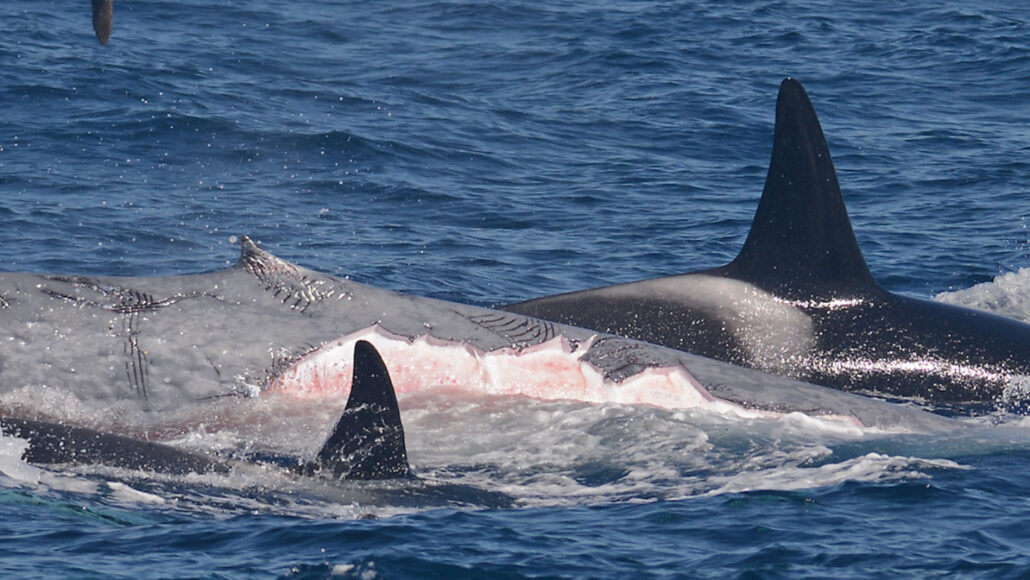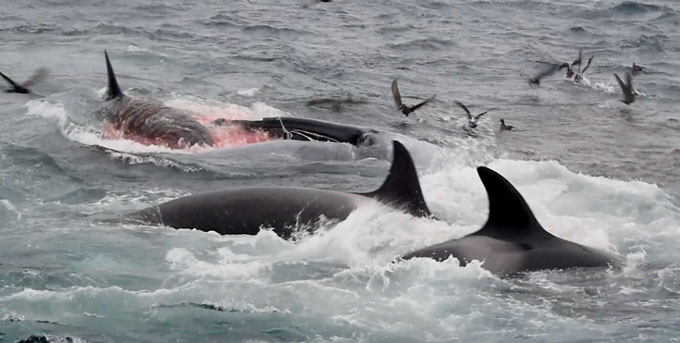Orcas can take down the largest animal on the planet
It’s a fight between the ocean’s top predator and the world’s largest animal

The pink flank on this blue whale calf marks where orcas stripped the flesh off. The whale died about eight minutes after this photo was taken. This event is the second of three captured on video showing that orcas hunt and kill these massive whales.
John Daw/Australian Wildlife Journeys
By Anna Gibbs
Killer whales are skilled assassins. They hunt everything from small fish to great white sharks. They’ve even been known to attack whales. But there had long been a question about whether killer whales — also known as orcas (Orcinus orca) — could kill the world’s largest animal. Now there’s no longer any doubt. For the first time, scientists have observed a pod of orcas bring down an adult blue whale.
“This is the biggest predation event on the planet,” says Robert Pitman. He is a cetacean ecologist who works at the Oregon State University Marine Mammal Institute in Newport. “We haven’t seen things like this since dinosaurs were here, and probably not even then.”
On March 21, 2019, a team of scientists in Western Australia headed out on a boat to observe orcas. Little did they realize they would see something no one had seen before. They shared their whale tale January 21 in Marine Mammal Science.
It was “a really ominous, bad-weather day,” recalls John Totterdell. He is a biologist at the Cetacean Research Centre. It’s in Esperance, Australia. When he and his group were still an hour away from their usual orca-observing site, they slowed down to remove some debris from the water. It was pouring rain, so it was hard to see the splashing at first. Then they noticed the telltale dorsal fins of killer whales.
“Within seconds, we realized they were attacking something big. Then,” says Totterdell, “we realized, oh my, it was a blue whale.”

A dozen orcas were attacking an adult blue whale (Balaenoptera musculus). Their prey appeared to be between 18 and 22 meters (59 and 72 feet) long. Its flank was covered in tooth marks. Most of its dorsal fin had been bitten off. The most brutal injury was on its face. The flesh of the whale’s snout was ripped away along the top lip, exposing bone. Like a battering ram, three orcas slammed into the whale’s side. Then another orca began feeding on its tongue. The blue whale finally died about an hour after the research team arrived.
Anatomy of an attack
Orcas tend to use the same methods every time they attack a large whale. They bite the whale’s fins, tail and jaw. This may be to slow it down. They also push the whale’s head underwater to prevent it from surfacing for air. Some may push it up from below so the whale can’t dive. “These are practiced large-whale hunters,” notes Pitman, who was an author of the paper. “They know how to do this.”
Orca hunts are brutal and usually involve the whole family. Females lead the charge. Orca calves will watch closely and sometimes join the ruckus. They’re almost “like excited little puppies,” says Pitman. The orcas will even share their meal with their extended family. The research team observed about 50 orcas picnicking on the blue whale after it died.
Blue whales not only are enormous but also can be fast in short bursts. This makes them hard to take down. But other than that, they don’t have many of the defenses that other whales use. Scientists have reported, for instance, that southern right whales whisper to calves to avoid catching the orcas’ attention.
The new paper also describes two other successful attacks carried out by many of the same orcas. The group killed a blue whale calf in 2019 and a juvenile blue whale in 2021. The events happened in the waters off Bremer Bay in Western Australia. It’s where a continental shelf under the ocean drops off into deeper waters. Here, migrating blue whales pass by a resident population of more than 150 orcas. It may be the largest grouping of orcas in the world.
The oceans used to host many more large whales. But in the 1900s, humans killed nearly 3 million of them. As many as 90 percent of blue whales disappeared.
No one knows if large whales played a significant role in orca diets in the past. It’s definitely possible, though, says Pete Gill. He is a whale ecologist at Blue Whale Study in Narrawong, Australia. Orcas and blue whales have been interacting for tens of thousands of years, he points out. “I imagine they have had this dynamic for quite a long time.”







